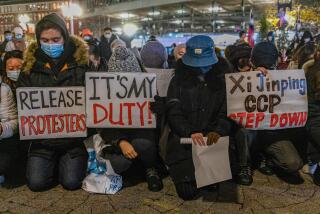Hong Kong Activist Drowns During Protest
- Share via
HONG KONG — An activist from here drowned Thursday during a symbolic plunge in the stormy sea near the disputed Diaoyu islands after Japanese patrol boats thwarted the protesters’ mission to reclaim the islands for China.
While 17 Japanese coast guard and military ships encircled a rusting tanker headed for the islands, David Chan, the protest group leader, and four other men roped themselves to the ship, put on life jackets and jumped overboard.
It was meant to be an act of defiance, not martyrdom, other group members on the ship said, to show that China is the rightful owner of the East China Sea islands that are also claimed by Taiwan and Japan.
The ship, dubbed the Diaoyu Island Defender, was the second this week to attempt a landing to plant the Chinese flag on one of the islands.
On board were 12 other activists and 42 journalists who watched in horror as Chan and another man, Fang Yu Yuen, 25, were dragged underwater alongside the ship and lost consciousness.
Fang was airlifted to a hospital on a nearby Japanese island; Chan died after Japanese doctors who were flown by helicopter to the ship were unable to revive him.
The Japanese rescue attempt was a brief, cooperative interlude in an increasingly bitter dispute over the barren rocks between southern Japan and China’s mainland.
Chan’s death is likely to heighten tensions between Japan, which has claimed what it calls the Senkaku Islands since 1895, and China, which dates back centuries its claim to the turf.
A wave of emotional anti-Japanese protests has swept Hong Kong, China, Taiwan and the United States since hard-line Japanese nationalists put up an aluminum lighthouse on one of the islands in July.
The two countries’ foreign ministers failed to defuse the situation over the islands when they met at the U.N. in New York on Tuesday, each insisting on sovereignty.
Chan, 45, had been at the fore of demonstrations over the Diaoyu islands since the U.S. handed them back to Japan in 1972.
As a student leader a quarter-century ago, he led thousands of people in the streets of Hong Kong to demand that the islands be returned to China. This month, he again stood in front of a crowd of 12,000, waving a red Chinese flag and condemning Japanese militarism through a bullhorn.
“I want to plant this flag on the island to show that it belongs to us,” Chan told The Times the day he set off on his last mission. “This issue has been unresolved too long.”
A longtime colleague, Au Pak Kuen, tearfully reminisced about their shared 25 years of protest and recounted the radio conversation he had with those on the ship before Chan’s death.
The group’s flag-planting mission had to be aborted because of dangerous seas and the Japanese coast guard’s presence.
“He felt quite lost when he heard they couldn’t go ashore to the Diaoyu Island when they could see it with their own eyes,” Au said. “That’s when they decided to at least swim in the Chinese sea.”
Au said Chan’s death would not stop a third voyage to the spot Oct. 5., but he noted that activists will hire a safer ship.
The Diaoyu Island Defender is a rusted 1,200-ton cargo vessel not meant to carry passengers. The protesters and journalists have been sleeping in two shipping containers bolted to the deck, with no sanitation facilities. Many of those on board, including Chan, have no sea training and cannot swim.
“I don’t think they were thinking of sacrifice,” Au said. “I don’t think they realized the danger of the rough sea.”
More to Read
Sign up for Essential California
The most important California stories and recommendations in your inbox every morning.
You may occasionally receive promotional content from the Los Angeles Times.













